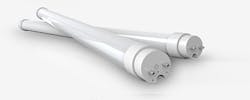A custom phosphor mix applied on LEDs delivers spectral power distributions matched to specific plant types and stages of plant growth while also delivering white light.
LED-based horticulture is a, pardon the pun, growing application, and Transcend Lighting has launched a new product concept for the market in the form of a LED-based T5 high-output tube. The LED tubes are designed for use with T5 fluorescent fixtures that are widely deployed in horticulture, and the solid-state lighting (SSL) will work with the existing ballasts, according to Transcend. The company’s added value is a phosphor-derived spectral power distribution (SPD) that can optimize plant growth and flowering.
Interested in more articles & announcements on LEDs in life science applications?
We have covered LED-based horticulture on a recurring basis including in a feature article in March 2015. SSL offers the same efficiency and long-life advantages in horticulture that it does in other general lighting applications. But LEDs are also being shown to optimize plant production by matching the wavelength of light to a plant’s needs.
Most of the horticultural lighting products on the market use a mix of deep blue and far red monochromatic color LEDs that science has shown benefit plants at different growth stages. But there are an abundance of theories about other wavelengths that might prove beneficial. Chuck DeMilo, vice president of sales and marketing at Transcend, said, “There is certainly a debate about complete photosynthetic spectrum.”
LEDs Magazine has announced its one-day Horticultural Lighting Conference! Visit horticulturelightingconference.com
to learn more.
Transcend takes the input of academia and its customers in crafting products with SPDs for specific applications. “Many companies build horticultural lights with just the blue/far red spectrum because of the hypothesis that these are the only wavelengths used for photosynthesis,” said DeMilo. “Although this hypothesis had some great logic, that chlorophyll A and B absorb these wavelengths more strongly, it turns out that plant growth is far more complicated than this. Some of our customers have grown fantastic plants using 100% green light during testing. This makes sense as plants evolved for billions of years under sunlight. Many recent studies have shown that full-spectrum lighting with properly balanced ratios of wavelengths, say red to far red or red to blue, supports the most efficient plant growth.”
Transcend has developed intellectual property in the area of phosphors and can create custom formulations for different SPDs. Some prior Transcend products have been integral fixtures that take a remote phosphor approach where the phosphor-coated optics are located separately from the blue LEDs, often called blue pumps. The advantages of remote phosphor are covered in one of our feature articles on the topic. For the T5 LED tubes, however, Transcend is depositing the phosphor mix directly on the blue-pump LEDs just as all phosphor-converted white LEDs are constructed.
We asked DeMilo about the comparative efficiency of the phosphor approach relative to using a mix of monochromatic LEDs in a horticultural product. See our recent feature on color LEDs to understand the basics behind each.
DeMilo said Transcend chose the phosphor approach for several reasons. Blue LEDs are more efficient than other monochromatic color LEDs and, even when you consider the Stokes loss in the phosphor approach, are a better choice, especially when considering the other reasons for the choice. The phosphor approach allows for more flexibility in SPDs and yields white light. And using all blue LEDs with identical thermal characteristics yields a more reliable end product.
You might not think that white light is important in the application. But as our horticulture feature discussed, growers still need white lighting to work with the plants. Ironically, one of the 30W T5 LED tubes that Transcend offers as a replacement for 64W fluorescent lamps happens to have a CRI of 94 due to the broad SPD and significant energy in the red region.
Today, Transcend is offering the LED tubes in two SPDs. One is a broad-SPD called Seed-to-Harvest Photosynthetic White, and the other is a red-centric Fruit-and-Flower Wide-Band Deep Red. The tubes sell for $70. But Transcend plans other formulations. For example, the company has even developed an SPD for salt- and fresh-water coral growth working with a European partner.







